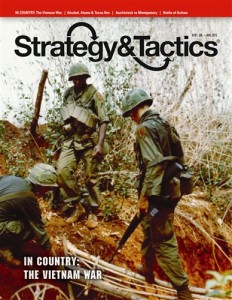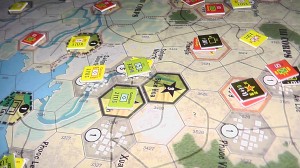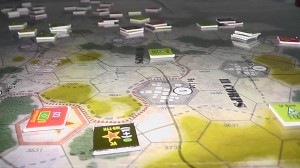 In Country – Vietnam
In Country – Vietnam
Components and size
The game “In Country – Vietnam”, by Strategy and Tactics is an operational game covering the American war effort in Vietnam from 1965 to 1975. The game can either be played in several discrete scenarios or as one campaign. Unit size is from Division down to Regiment and Divisions can be broken down during the game to deploy individual regiments. Turn length is one week, one hex covers 30 miles.
The game is played on two coloured maps, which are easy to read with big hexes, which make it easy to see the terrain even when units are deployed in the hex. The counters show the usual NATO symbols denoting unit types, in addition, the game features several information markers such as “suppressed” or “operation complete”.
Sequence of play
Each turn starts with the Communist player deploying reinforcements, refitting eliminated units by paying for them using Military/Political VPs gained through capturing Allied-held positions and / or eliminating Allied units. Once the price for refitting has been paid, a die-roll decides when and if the refitted unit will enter play. This is then followed by the Communist movement phase, which is followed by Allied defensive air bombardment. After calculating the bombardment results (elimination; suppression, which halves combat factors, and loss of Allied aircraft through AA activity), the Communist combat phase begins. This is played using one of two possible CRTs and a d6. Combat factors are added, ratios determined and modifiers (enveloping, firebases, supply dumps) are factored in. After this phase, all suppression counters are removed and the Allied player starts their turn. On their turn, they get a second airstrike phase just before combat.

Narrative and gameplay
The game plays surprisingly fast, considering the high number of die rolls (example: bombardment of one hex with 6 units requires six “to-hit” die rolls on the bombardment table, one for each unit). Like with every strategic game, large parts of map will not be used once the set-up is complete and the defensive forces are ensconced. The Communist player is on the eternal offensive, in order to capture allied cities, the Allied player is in a much stronger position due to:
a) Better equipment and stronger forces
b) No need to consider supply
c) Air support (a game decider, since by suppressing attackers, whole tactical stratagems can fall apart even before the first combat die is rolled)
I have played around 15 turns so far, play gets faster as you get into it, once you understand the basic strategies and opportunities. Game balance does not exist, because this simulation puts a lot of emphasis on historic accuracy, and in the Tet-offensive, for example, the Communist were shattered and rendered incapable of achieving much for the next couple of years, according to their general, Giap. During the refit phase in my most recent game, I “managed” to roll so badly to completely eliminate several units and refit others so many turns later that they would have come back only after the end of the scenario.
 In all, I think this is a good game, it plays less tight than Tonkin. By this, I mean it was less claustrophobic to me. With Tonkin, I sometimes felt almost like playing a tactical game. In Country Vietnam relies on Victory Points achieved by capturing objectives and destroying enemy units. These points are used as “currency” for paying for refitting. So, the players need to decide if they want to try and bring back units and get more strength in the field while at the same time reducing their VP account, which decides who wins in the in. Very interesting choices have to be made as a result.
In all, I think this is a good game, it plays less tight than Tonkin. By this, I mean it was less claustrophobic to me. With Tonkin, I sometimes felt almost like playing a tactical game. In Country Vietnam relies on Victory Points achieved by capturing objectives and destroying enemy units. These points are used as “currency” for paying for refitting. So, the players need to decide if they want to try and bring back units and get more strength in the field while at the same time reducing their VP account, which decides who wins in the in. Very interesting choices have to be made as a result.
In order to make game play a little more interesting, the Communist player will use “Fog o’ War”, i.e. will place his units face down and only under certain circumstances (in battle, or through “intelligence gathering”) will they be made visible to the opponent. In addition, the Communists get a number of “dummy units”, which have no value, but make the stack “look more impressive” until revealed (very much like in Panzergruppe Guderian, with the significant difference that in PGG, the Russion player does not know his stacks’ make-up either until they are revealed.